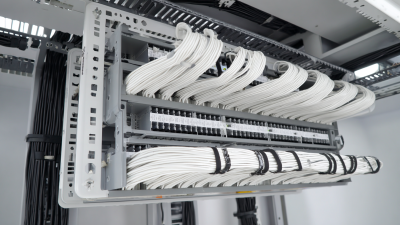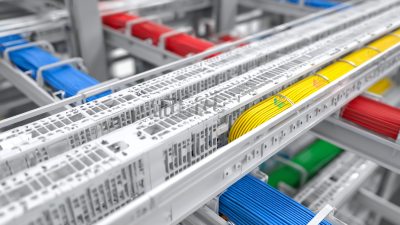What is a Cable Rack? Understanding Its Importance in Efficient Cable Management
In the fast-paced world of technology and telecommunications, efficient cable management is crucial for the optimal functioning of systems and infrastructure. One essential component in achieving this efficiency is the cable rack. A cable rack serves as a structured framework designed to support and organize various cables, ensuring they are securely held in place while maintaining ease of access and reducing clutter. As organizations increasingly rely on complex network configurations and intricate wiring systems, the significance of these racks cannot be overstated.
Moreover, a well-designed cable rack not only enhances the aesthetic appeal of a workspace but also minimizes the risk of damage to cables, which can lead to costly downtime and repairs. By keeping cables neatly arranged and properly ventilated, cable racks help in prolonging the lifespan of the wiring and improving overall system performance. This article will delve deeper into the definition and critical role of cable racks in promoting efficient cable management, shedding light on best practices and considerations for selecting the right type for various applications. Understanding these aspects is vital for anyone looking to optimize their cable management strategies and ensure their technological frameworks are both functional and organized.

The Role of Cable Racks in Preventing Downtime and Enhancing Productivity
 Cable racks play a crucial role in maintaining an organized and efficient workspace, especially in environments where numerous cables are in use, such as data centers and manufacturing facilities. By providing a structured method for storing and routing cables, these racks help prevent tangling and damage. This organization is not just about aesthetics; it directly impacts operational efficiency and productivity. When cables are neatly arranged, it simplifies troubleshooting and maintenance efforts, allowing technicians to quickly identify and address issues without unnecessary delays.
Cable racks play a crucial role in maintaining an organized and efficient workspace, especially in environments where numerous cables are in use, such as data centers and manufacturing facilities. By providing a structured method for storing and routing cables, these racks help prevent tangling and damage. This organization is not just about aesthetics; it directly impacts operational efficiency and productivity. When cables are neatly arranged, it simplifies troubleshooting and maintenance efforts, allowing technicians to quickly identify and address issues without unnecessary delays.
Moreover, effective cable management through the use of cable racks significantly reduces the risk of downtime. In industries where every minute of operation counts, a well-managed cable system ensures that power and data flow seamlessly. Disorganized cables can lead to unexpected outages or failures that may halt production or disrupt services. By investing in cable racks, companies can enhance their workflow, minimize interruptions, and ultimately improve their bottom line. In a competitive business landscape, where efficiency can distinguish a leader from a laggard, the importance of cable racks becomes abundantly clear.
Key Statistics on Cable Management and Its Impact on Operational Efficiency
Effective cable management is essential in various settings, particularly in data centers and office environments, where an overwhelming number of cables can lead to chaos. Statistics indicate that companies can save up to 30% in operational costs through improved cable management practices. By organizing and securing cables using cable racks, businesses not only enhance safety but also minimize the risk of downtime caused by tangled or damaged cables.
Moreover, a structured cable management approach contributes to better airflow and cooling in equipment rooms, which is crucial for maintaining optimal performance. Studies have shown that efficient cable management can improve system accessibility, reducing maintenance time by as much as 25%. Ultimately, prioritizing effective cable management through the use of tools like cable racks directly correlates with operational efficiency, empowering organizations to function at their best while reducing overhead costs.
Cable Management Efficiency Statistics
This chart illustrates key statistics on cable management efficiency, highlighting the significant impact on operational performance. The data shows the relationship between efficient cable management practices and operational downtime. Efficient cable management can reduce downtime by a considerable percentage.
Comparative Analysis of Cable Rack Materials and Their Strength Ratings
When it comes to effective cable management, the choice of cable rack material plays a crucial role in determining the overall strength and durability of the installation. Generally, cable racks are constructed from various materials, including steel, aluminum, and plastic. Steel cable racks are renowned for their exceptional load-bearing capacity and resistance to corrosion, making them ideal for heavy-duty applications in industrial settings. Their robust design can accommodate a significant number of cables, ensuring a tidy and organized setup.
On the other hand, aluminum cable racks offer a lightweight alternative with decent strength ratings. They are particularly advantageous in environments where weight reduction is essential, such as in aircraft and automotive industries. Although less strong than steel, aluminum racks still provide adequate support for moderate cable loads while being easier to install and relocate. Lastly, plastic cable racks, often used for residential or light commercial purposes, are cost-effective and resistant to some environmental factors. However, their strength ratings are typically lower than metal options, making them more suitable for light-duty applications. Comparing these materials allows users to select the right cable rack that best meets their specific requirements for strength and application.

Best Practices for Cable Rack Installation and Maintenance in Industrial Settings
Cable racks are essential components in industrial settings, playing a crucial role in organizing and managing cables effectively. Proper installation of cable racks involves careful planning to accommodate the specific needs of the facility. This includes assessing the type of cables being used, their weight, and the layout of the space. One best practice is to ensure that cable racks are positioned away from high foot traffic areas and that they allow for sufficient ventilation to prevent overheating. Proper spacing and securing of cables within the racks can also minimize the risk of damage and interference.
Maintenance of cable racks is equally important to ensure longevity and safety. Regular inspections should be conducted to check for signs of wear, corrosion, or physical damage. Keeping the racks clean and free of dust can help maintain optimal performance. Additionally, any loose or disordered cables should be promptly organized to prevent entanglement or strain. Following these best practices can significantly enhance the efficiency of cable management in industrial environments, ultimately contributing to smoother operations and reduced downtime.
Emerging Trends in Cable Management Solutions for Modern Data Centers
In the ever-evolving landscape of modern data centers, effective cable management has become paramount. Emerging trends in cable management solutions are now focusing on optimizing space utilization while enhancing accessibility and aesthetics. Innovations such as modular cable trays and adjustable racks are gaining traction, allowing for dynamic configurations that can adapt to changing infrastructure needs. This flexibility not only streamlines maintenance but also supports the rapid scaling of IT operations.
Furthermore, the integration of smart technologies is revolutionizing the way we approach cable management. IoT-enabled solutions are being developed to monitor cable health and temperature in real-time, providing insights that help prevent overheating and downtime. Coupled with advanced labeling techniques and the use of color-coded cables, these trends contribute to improved organizational efficiency and reduced response times during troubleshooting. As data centers continue to expand, embracing these modern cable management strategies will be crucial for ensuring optimal performance and reliability.
Related Posts
-

Exploring Innovative Alternatives to the Best Cable Rack Solutions for Efficient Organization
-

Quality Driven Chinese Manufacturing in Global Leader Best Cable Management Tray
-

Ultimate Guide to Efficiently Organizing Cables with Cable Management Trays
-

2025 Global Market Insights: Transforming Spaces with the Best Plastic Cable Tray Solutions
-

7 Reasons Why Black Cable Tray is the Ultimate Solution for Your Wiring Needs
-

Transform Your Space: The Ultimate Guide to Using Cable Hangers for a Clutter-Free Home
